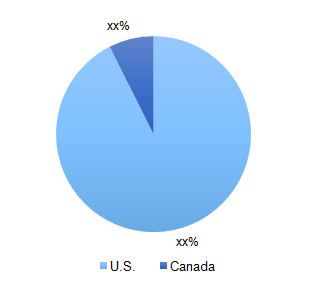
North America Online Baby And Infant Apparel Market Size and Forecast, By Age [Infant (0-1), Toddler Boy (1 - 3), Toddler Girl (1-3)], By Country (U.S., Canada), And Trend Analysis, 2014 - 2024
- Published: September, 2017
- Format: Electronic (PDF)
- Number of pages: 45
- Industry: Consumer Goods
Industry Insights
The North America online baby apparel market was valued at USD 2.32 billion in 2016 and is expected to grow over the next few years. Factors such as increasing number of e-shoppers, sparse time, a broader variety of clothes, low shipping costs, and easy return options are expected to play a critical role in driving the online infant apparel market growth over the next few years.
North America online baby apparel market revenue share, by country, 2016 (%)

Although the global e-commerce industry was estimated to be approximately USD 2 trillion in 2016, a mere 8.7% of the total retail shopping, the sector is expected to continue to grow significantly over the next few years. The abovementioned factors are anticipated to make a significant contribution to this growth.
Besides shopping for adult clothes, the demand for children’s clothes, particularly for babies has been growing significantly over the past few years. Availability of discounts and segregation of cloth materials has resulted in more number of parents shifting their purchasing decision from retail stores to online research.
Rising demand for baby clothes, particularly organic ones, is expected to drive the online baby apparel market. A heightened sense of fashion among parents and youngsters alike, along with stylish trends of “Mini-me” offered by big brands such as Gucci and Ralph Lauren is another factor which will propel online infant clothing market growth. In addition, this will lead to an increase in the per capita spending on infants and toddlers, thereby, escalating the revenues of the industry.
The number of Americans shopping online increased from a meagre 22% in 2000 to 79% in 2016. Parents spend more of their budget shopping online as compared to non-parents on account of family commitments and lack of time. The increasing number of hours spent online, particularly on shopping websites, is expected to trigger growth.
The declining number of births in the U.S. is expected to impact the growth of the online baby clothing market over the forecast period. However, rising number of baby shoppers coupled with the increasing size of the young population migrating to the region is expected to provide an opportunity for the industry over the projected period.
Segmentation by Age
• Infant
• Toddler Boy
• Toddler Girl
Most parents use unisex clothes for babies up to one year of their age. The inhibition of buying clothes online among this age group owing to the lack of feeling the material as well as the high level of insecurity of their infants developing a rash due to allergies of cloth is expected to result in low penetration of e-commerce in this segment. As of 2016, the online infant clothes market accounted for 15.6% of the overall regional share and is expected to witness slow growth.
Toddler girl’s clothing was the largest segment contributing to USD 1.41 billion in 2016. Availability of a large range of dresses including skirts, frocks, tops, tee-shirts, and leggings in various colors for casual as well as party wear for girls is expected to augment the growth of the segment. Fashion is likely to continue being the singular driving factor for this segment.
Segmentation by Country
• U.S.
• Canada
U.S. was the largest market for online baby & infant apparel in 2016, mainly driven by the high patterns of consumers for purchasing products online. High penetration of internet in the region, translating into a massive size of e-shoppers has resulted in the country dictating the regional trends for North America online infant apparel market.
A large number of working women coupled with the convenience of online delivery has resulted in more number of consumers purchasing their products online. E-commerce websites such as Amazon and e-bay have a significant share of the e-commerce market in the country. Online presence of brands such as GAP, Gucci, and Ralph Lauren as well as other dedicated baby products sites has resulted in the country achieving maturity in its purchasing patterns.
The number of immigrants is expected to increase significantly in Canada over the next few on account of the “Express Entry” policy to boost the domestic economy which allows a large pool of population to settle down in the country. The rise in the birth rate over the next few years is expected to result in boosting the market in the country over the next few years at an estimated CAGR of 9.2%.
The country is expected to eat into the U.S. chare within the North American market. However, the larger economy is likely to sustain its dominant position during the forecast period. Nonetheless, the DINK (Double Income, No Kid) trend is anticipated to affect the number of births in the U.S. adversely, thereby impacting the online infant apparel market.
Competitive Landscape
Carter’s Inc., Gap Inc., The Children's Place Retail Stores Inc., The Gymboree Corporation, H&M, and Macy’s were some of the prominent players within the North America online baby apparel industry in 2016. In addition to these, there are several portals which market a collection of brands for infants as well as kids. Some of these include Diapers.com, Amazon, and Babies”R”Us among several others.

Choose License Type
- World's largest premium report database
- Transparent pre & post sale customer engagement model
- Unparalleled flexibility in terms of rendering services
- Safe & secure web experience
- 24*5 Research support service
